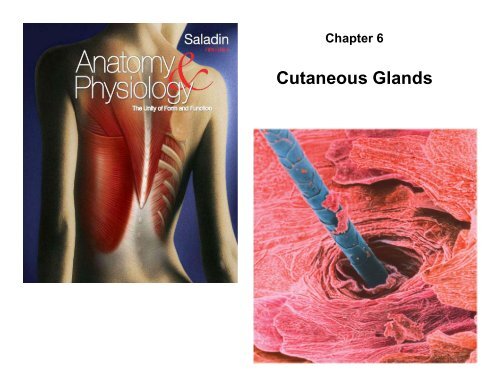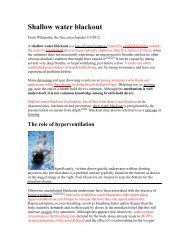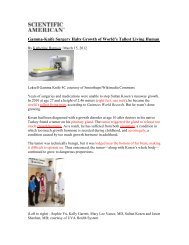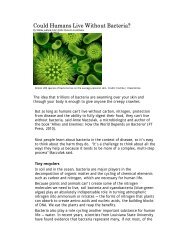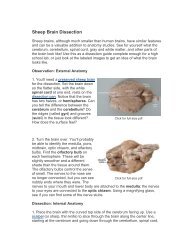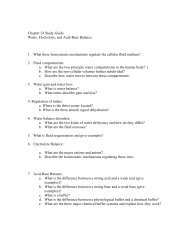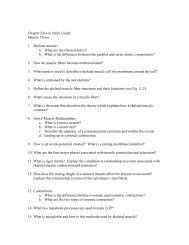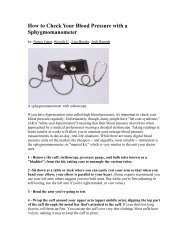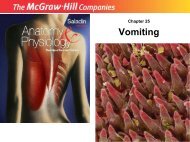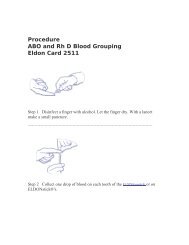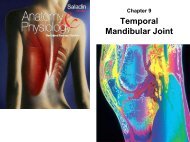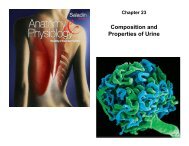Cutaneous Glands
Cutaneous Glands
Cutaneous Glands
- No tags were found...
Create successful ePaper yourself
Turn your PDF publications into a flip-book with our unique Google optimized e-Paper software.
Chapter 6<br />
<strong>Cutaneous</strong> <strong>Glands</strong>
<strong>Cutaneous</strong> <strong>Glands</strong><br />
Lumen<br />
Secretory<br />
cells<br />
Gland<br />
Hair follicle<br />
Myoepithelial Lumen<br />
cells<br />
Secretory cells<br />
(c) Sebaceous gland<br />
(a) Apocrine gland<br />
(b) Merocrine gland<br />
the skin has five types of glands<br />
- merocrine sweat glands<br />
- apocrine sweat glands<br />
- sebaceous glands<br />
- ceruminous glands<br />
- mammary glands
Sweat <strong>Glands</strong> (Sudoriferous)<br />
• two kinds of sweat (sudoriferous) glands<br />
– merocrine (eccrine) sweat glands<br />
• most numerous skin glands - 3 to 4 million in adult skin<br />
• are simple tubular glands<br />
• watery perspiration that helps cool the body<br />
• myoepithelial cells – contract in response to stimulation by<br />
sympathetic nervous system and squeeze perspiration up the duct<br />
– apocrine sweat glands<br />
• occur in groin, anal region, axilla, areola, bearded area in mature<br />
males<br />
• ducts lead to nearby hair follicles<br />
• produce sweat that is thicker, milky, and contains fatty acids<br />
• scent glands that respond to stress and sexual stimulation<br />
• develop at puberty<br />
• pheromones – chemicals that influence the physiology of<br />
behavior of other members of the species<br />
• bromhidrosis - disagreeable body odor produced by bacterial<br />
action on fatty acids
Sweat<br />
• begins as a protein-free filtrate of blood plasma<br />
produced by deep secretory portion of gland<br />
– potassium ions, urea, lactic acid, ammonia, and some<br />
sodium chloride remain in the sweat, most sodium<br />
chloride reabsorbed by duct<br />
– some drugs are also excreted in sweat<br />
– on average, 99% water, with pH range of 4 to 6<br />
• acid mantle – inhibits bacterial growth<br />
– insensible perspiration – 500 ml per day<br />
• does not produce visible wetness of skin<br />
– diaphoresis – sweating with wetness of the skin<br />
• exercise – may lose one liter of sweat per hour
Sebaceous <strong>Glands</strong><br />
• sebum – oily secretion produced by<br />
sebaceous glands<br />
• flask-shaped glands with short ducts<br />
opening into hair follicle<br />
• holocrine gland – secretion consists of<br />
broken-down cells<br />
– replaced by mitosis at base of gland<br />
• keeps skin and hair from becoming dry,<br />
brittle, and cracked<br />
• lanolin – sheep sebum<br />
– We wash off our sebum so we can rub into<br />
our skin the sebum of sheep!
Ceruminous <strong>Glands</strong><br />
• found only in external ear canal<br />
• ceruminous gland secretion<br />
combines with sebum and dead<br />
epithelial cells to form earwax<br />
(cerumen)<br />
– keep eardrum pliable<br />
– waterproofs the canal<br />
– kills bacteria<br />
– makes guard hairs of ear sticky to help<br />
block foreign particles from entering<br />
auditory canal<br />
• simple, coiled tubular glands with<br />
ducts that lead to skin surface
Mammary <strong>Glands</strong><br />
• breasts (mammae) of both sexes contain very<br />
little glandular material<br />
• mammary glands – milk-producing glands of<br />
females that develop only during pregnancy<br />
and lactation<br />
– modified apocrine sweat gland<br />
– richer secretion released by ducts opening into the nipple<br />
• mammary ridges or milk lines<br />
– two rows of mammary glands in most mammals<br />
– primates kept only anterior most glands<br />
• additional nipples (polythelia)<br />
– may develop along milk line


